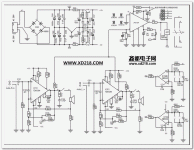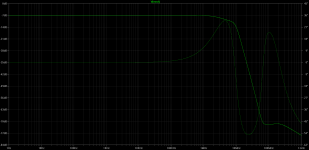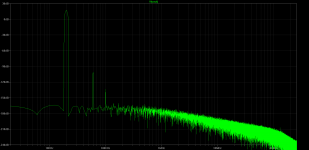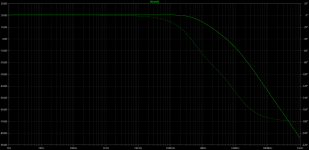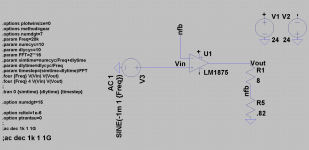great data vacuphile
I was just about to point out the high distortion when I noticed it was normalized, so not in scale to first harmonic
thanks
I was just about to point out the high distortion when I noticed it was normalized, so not in scale to first harmonic
thanks
here is a couple of circuits I found on the web...
One more schematics...
Attachments
Thank you, a little too little res...
What is the reason for using voltage feedback here?
Stability?
Zero VDC at the output?
Possibility of disconnecting speaker without destroying TDA?
What is the reason for using voltage feedback here?
Stability?
Zero VDC at the output?
Possibility of disconnecting speaker without destroying TDA?
Has anybody tried pure current drive with a fullrange speaker in a sealed box?
Can they share some of their experiences please?
What happens to the Bass? Midrange? Treble? Dialogue, Music, Effects? as compared to a voltage drive in an A/B test?
Is it best to be used as a subwoofer and a satellite, separately or as a fullrange driver?
Thanks in advance!
Not fullrange, but broadband ( Manger and Jordan).
Seems it has not yet been referenced,
Current amplifier using error feedforward
by Wilson, known for his 3 and 4 transistors current mirrors
which were described at the beginning of this article
Current mirrors, amplifiers and dumpers
published in Wireless World, december 1981 :
www.audiofaidate.org/it/articoli/Current_mirrors.pdf
(downloading may be quite low).
Current amplifier using error feedforward
by Wilson, known for his 3 and 4 transistors current mirrors
which were described at the beginning of this article
Current mirrors, amplifiers and dumpers
published in Wireless World, december 1981 :
www.audiofaidate.org/it/articoli/Current_mirrors.pdf
(downloading may be quite low).
Nelson Pass has an excellent article on "partial" current drive of full range speakers in sealed boxes.Has anybody tried pure current drive with a fullrange speaker in a sealed box?
Can they share some of their experiences please?
What happens to the Bass? Midrange? Treble? Dialogue, Music, Effects? as compared to a voltage drive in an A/B test?
Whether 'full' current drive is better depends on the speaker & box. His article has loadsa good examples.
Whether its better for subs, satellites etc also depends on the EXACT speakers & boxes.
Seems it has not yet been referenced,
Current amplifier using error feedforward
by Wilson, known for his 3 and 4 transistors current mirrors
which were described at the beginning of this article
Current mirrors, amplifiers and dumpers
published in Wireless World, december 1981 :
www.audiofaidate.org/it/articoli/Current_mirrors.pdf
(downloading may be quite low).
Nice article.
seems to be working...
... however I do not have the models of the opamps from this article.
Could anyone propose which LT opamps will be working without the oscillations in this circuit?
Attached sims and asc file for play, cheers!
... however I do not have the models of the opamps from this article.
Could anyone propose which LT opamps will be working without the oscillations in this circuit?
Attached sims and asc file for play, cheers!
Attachments
Last edited:
Wilson's 1A class B dumping VCCS
http://www.audiofaidate.org/it/articoli/Current_mirrors.pdf
Thanks for you interest.
As any error correction amplifier, the Wilson's amp is intellectually appealing.
Maybe it could be the basis for a study of a new version with modern components or could give ideas for other current amplifier circuits using error correction. Feedforward is attractive here because it is so easy to add the two necessary values at the output as they are currents.
I never saw schemes like those of figures # 7, 8 and 9 and around A2 and A3 of figure # 11. The scheme around A4 of this last figure is more familiar, it's a current conveyor.
http://www.audiofaidate.org/it/articoli/Current_mirrors.pdf
Thanks for you interest.
As any error correction amplifier, the Wilson's amp is intellectually appealing.
Maybe it could be the basis for a study of a new version with modern components or could give ideas for other current amplifier circuits using error correction. Feedforward is attractive here because it is so easy to add the two necessary values at the output as they are currents.
I never saw schemes like those of figures # 7, 8 and 9 and around A2 and A3 of figure # 11. The scheme around A4 of this last figure is more familiar, it's a current conveyor.
Last edited:
LM1875 - is it true?
Hi
I found a model for LM1875 and simulations attached bellow are showing its great potential as trasnconductance amp.
If the model is true, it will outperform all of the rest chipamps🙄
Hi

I found a model for LM1875 and simulations attached bellow are showing its great potential as trasnconductance amp.
If the model is true, it will outperform all of the rest chipamps🙄
Attachments
I'd like to buy an actual current drive amplifier, capable of say 50W or 100W of output and a high enough output impedance (no need for crazy high output impedance and real current source), and all the needed protections.
Why there is nothing on the market is beyond me...
Of course it requires some caution from the user (avoid impedance peaks and the like), but so do other stuff in audio like active filters, kW amplifiers, Beryllium toxic domes, etc...
Why there is nothing on the market is beyond me...
Of course it requires some caution from the user (avoid impedance peaks and the like), but so do other stuff in audio like active filters, kW amplifiers, Beryllium toxic domes, etc...
POS you might be interrested in this circuit:
Free Shipping LM3886TF amplifier circuit board Wu Gang mono amplifier board lm3886 amplifier Fully Assembled and Tested-in Amplifier from Consumer Electronics on Aliexpress.com | Alibaba Group
the standard value give 4 Ohm output resistance, adjust to your needs, mainly R10 and feedback resistors
cheers
Paul
Free Shipping LM3886TF amplifier circuit board Wu Gang mono amplifier board lm3886 amplifier Fully Assembled and Tested-in Amplifier from Consumer Electronics on Aliexpress.com | Alibaba Group
the standard value give 4 Ohm output resistance, adjust to your needs, mainly R10 and feedback resistors
cheers
Paul
Hello Paul
Thanks for the heads up.
Did you try it?
Is it a real current source amplifier?
The description states it is meant for 4 to 8 ohms loudspeakers. What if I connect a 16 ohms driver?...
How does the modification of the output resistance affect the output power capacity?
Lets say I want something like 50 ohms...
Thanks for the heads up.
Did you try it?
Is it a real current source amplifier?
The description states it is meant for 4 to 8 ohms loudspeakers. What if I connect a 16 ohms driver?...
How does the modification of the output resistance affect the output power capacity?
Lets say I want something like 50 ohms...
I bought some kits but finaly decided to use them without the "current feedback components", not finished yet.
I think the original idea was to produce some bass boost at the speaker f0
you sure can use it with 16 ohms driver with less effect
I would suggest to simulate in LTSPICE with universal op amp as lm3886
these are my parameters (I am not an expert)
good enough to adjust feedback resistors and check output resistance:
you change Rload and measure Amps in Rload
Prefix X
InstName U2
SpiceModel level.2
Value
Value2 Avol=0.5Meg GBW=8Meg Slew=19Meg
SpiceLine ilimit=10 rail=0 Vos=0 phimargin=45
SpiceLine2 en=0 enk=0 in=0 ink=0 Rin=1Meg
I think the original idea was to produce some bass boost at the speaker f0
you sure can use it with 16 ohms driver with less effect
I would suggest to simulate in LTSPICE with universal op amp as lm3886
these are my parameters (I am not an expert)
good enough to adjust feedback resistors and check output resistance:
you change Rload and measure Amps in Rload
Prefix X
InstName U2
SpiceModel level.2
Value
Value2 Avol=0.5Meg GBW=8Meg Slew=19Meg
SpiceLine ilimit=10 rail=0 Vos=0 phimargin=45
SpiceLine2 en=0 enk=0 in=0 ink=0 Rin=1Meg
Thanks for the feedback
Unfortunately I have no experience with LTSPICE and my electronic knowledge is close to zero so I will probably just wait for something else.
I'd be more interested in a finished product, or an easy to assemble (hypex like) solution...
In the meantime the easiest and cheapest solution for me remains a high power resistor in series with a high power amp...
Unfortunately I have no experience with LTSPICE and my electronic knowledge is close to zero so I will probably just wait for something else.
I'd be more interested in a finished product, or an easy to assemble (hypex like) solution...
In the meantime the easiest and cheapest solution for me remains a high power resistor in series with a high power amp...
the kit is easy to build, done in one hour
I changed one or two capacitors, (bought from selectronic)
add a PSU, you can get Kits as well
I will have a look in spice for you for 50 Ohms / 16 Ohms driver
cheers and thanks for rephase, great tool that will be put in good use.
I changed one or two capacitors, (bought from selectronic)
add a PSU, you can get Kits as well
I will have a look in spice for you for 50 Ohms / 16 Ohms driver
cheers and thanks for rephase, great tool that will be put in good use.
speaker distortion and current drive
In the Blowtorch thread, we have discussed voltage x current drive about a week ago.
I have summarized the results of my measurements, done more measurements and created web pages. It definitely belongs rather to this thread than to the BT thread.
Current drive of speakers and speaker distortion
especially
Current drive of speakers and speaker distortion
In the Blowtorch thread, we have discussed voltage x current drive about a week ago.
I have summarized the results of my measurements, done more measurements and created web pages. It definitely belongs rather to this thread than to the BT thread.
Current drive of speakers and speaker distortion
especially
Current drive of speakers and speaker distortion
In the Blowtorch thread, we have discussed voltage x current drive about a week ago.
I have summarized the results of my measurements, done more measurements and created web pages. It definitely belongs rather to this thread than to the BT thread.
Current drive of speakers and speaker distortion
especially
Current drive of speakers and speaker distortion
Very nicely done indeed. Can you tabulate your results to make it easy to see the trends?
- Home
- Amplifiers
- Solid State
- Current drive for Loudspeakers
